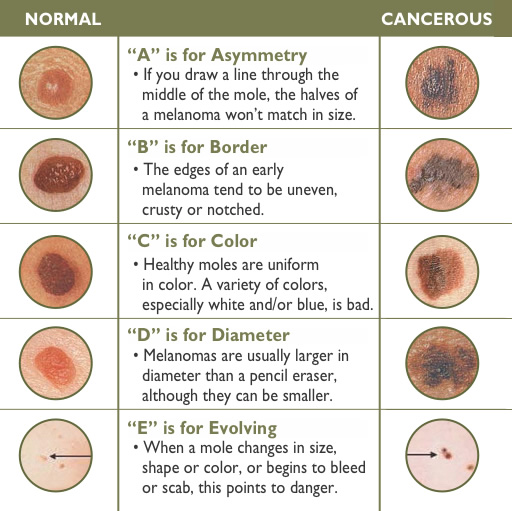|
Early signs of Skin CancerClint Merrick, MD The statistics are extraordinary. Each year there are more new skin cancers diagnosed than all the cases of breast, prostate, lung and colon cancer combined. In fact, in the last three decades, more people have had skin cancer than all other cancers combined! One in five Americans will develop skin cancer in their lifetime. Annually 3.5 million cases of skin cancers are diagnosed. There is a good chance you know someone who has had skin cancer. Of the three main types, Basal Cell Carcinoma (BCC) is the most common. This form of skin cancer is rarely fatal, but can be very disfiguring in sensitive areas if not caught early and handled properly.  Squamous Cell Carcinoma (SCC) is slightly more aggressive. In fact, nearly as many people die of SCC annually as from melanoma. SCC can arise from ‘precancerous’ spots on the skin known as actinic keratosis. These are dry flaky patches on the skin in sun exposed areas. SCC often presents as a non-healing ulcer. Melanoma, the most aggressive form of skin cancer, is fortunately also the least common. Of the 77,000 new cases diagnosed each year about 10,000 will die from the disease. Melanomas are often pigmented. Unlike normal, benign moles, Melanomas often present with one or more of the tell-tale “ABCDE’s”.
While skin cancer may have an underlying genetic cause, the vast majority of skin malignancies develop as a result of sun exposure. The total number of sunburns in one’s life is predictive of the chance to develop skin cancer. Reducing sun exposure is the key to avoiding future cancers. “SPF” is a rating on a sunscreen that measures its effectiveness at blocking only a portion of ultraviolet light known as the UVB spectrum. It is now known that another portion of ultraviolet light, known as UVA, is also harmful. Its effects include premature skin aging, as well as developing skin cancer. It is essential to make sure that the sunscreen you are using protects against both UVA and UVB. Skin surveillance is also essential. Many cancers will develop in areas that are impossible to see yourself. Have a significant other or friend look for abnormal spots or spots that are changing. Change is one of the best predictors of skin cancer. Time is of the essence, as even a couple of months can mean the difference between a superficial and invasive melanoma. Often wait times to see a dermatologist can be months. Many patients don’t realize that they have options. Make an appointment with a family physician if you are concerned. Or, you can make an appointment directly with me to be screened. As a plastic surgeon, I see many skin cancers in places where scarring would be a concern. As a result I help many people with diagnosis of skin cancers. Together with the OakLeaf Network Pathology physicians, we can provide simple one step biopsy, complete cancer removal and excellent cosmetic results. DON’T WAIT! Get those abnormal spots looked at right away! Morbidity and mortality from skin cancer is preventable!Dr. Merrick – Merrick Plastic & Hand Surgery |



